Transurban Group Bundle
How did Transurban Group become a global leader in toll roads?
Journey back in time to discover the remarkable Transurban Group SWOT Analysis, a company that revolutionized urban mobility. From its humble beginnings in Melbourne, Australia, Transurban Group has transformed the landscape of infrastructure projects worldwide. This is the story of how a vision for efficient toll roads became a global reality.
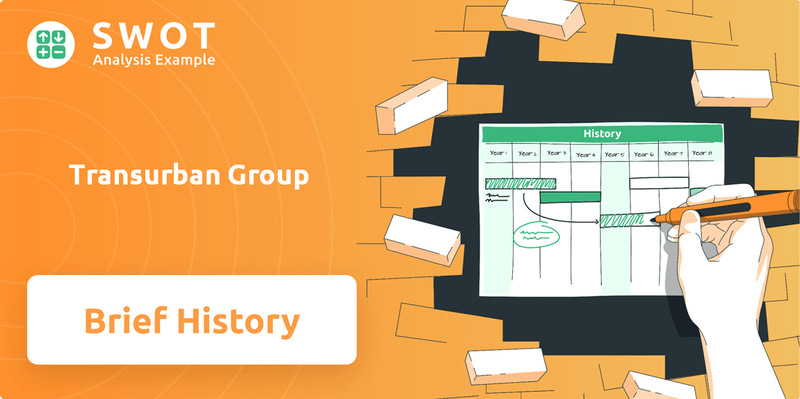
Delving into the brief history of Transurban Group reveals a story of strategic innovation and impressive growth. Founded in 1995, the Transurban company quickly recognized the potential of technology to enhance toll road management, setting the stage for its expansion. Its evolution showcases how careful planning and adaptability can transform an Australian infrastructure initiative into a multinational enterprise, shaping the future of transportation.
What is the Transurban Group Founding Story?
The Transurban Group, a prominent player in the infrastructure sector, has a compelling founding story. The company's origins trace back to April 24, 1995, in Melbourne, Australia. Its creation was a direct response to the growing need for innovative solutions to urban congestion, particularly in major Australian cities.
The core idea behind Transurban was to leverage private sector expertise and investment to develop and manage toll road networks. This approach aimed to address the limitations of traditional public works projects. The initial business model focused on securing long-term concessions from governments to design, build, finance, operate, and maintain these critical infrastructure assets.
The CityLink project in Melbourne was a pivotal undertaking that defined Transurban's early operations. This project involved a complex network of tunnels and elevated roadways and introduced electronic tolling on a large scale in Australia. The financial structure for such projects typically involved a combination of equity from institutional investors and substantial debt financing. The mid-1990s in Australia saw a growing emphasis on public-private partnerships (PPPs) for infrastructure, which provided a favorable environment for Transurban's business model.
Here are some key aspects of the company's founding and early development:
- Founding Date: April 24, 1995, in Melbourne, Australia.
- Initial Focus: Addressing urban congestion through toll road infrastructure.
- Business Model: Securing long-term concessions for toll road projects.
- First Major Project: The CityLink project in Melbourne.
- Funding: A mix of equity and debt financing.
Transurban Group SWOT Analysis
- Complete SWOT Breakdown
- Fully Customizable
- Editable in Excel & Word
- Professional Formatting
- Investor-Ready Format
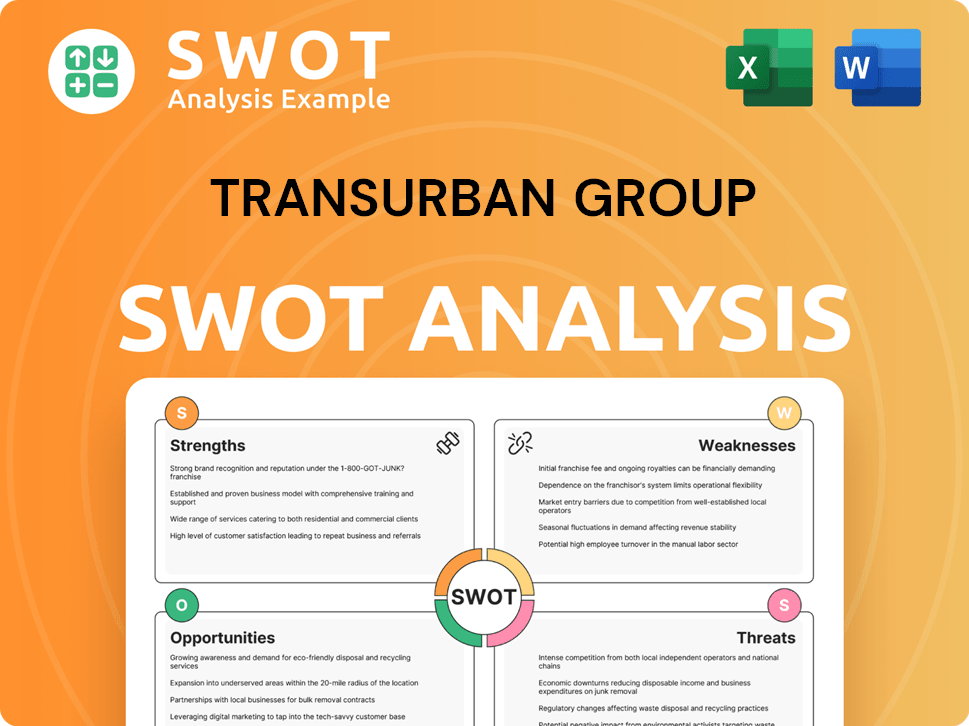
What Drove the Early Growth of Transurban Group?
The early growth of Transurban Group was largely defined by securing and developing major urban toll road projects. Following the successful launch of the CityLink project in Melbourne, which began construction in 1996 and became fully operational by 2000, the company honed its operational capabilities. This initial success set the stage for expansion, demonstrating its expertise in electronic tolling and integrated traffic management.
In the early 2000s,
Early team expansion involved bringing in expertise in engineering, finance, and public relations to manage increasingly complex projects and stakeholder relationships. The market reception to Transurban's projects was generally positive, as they offered solutions to persistent traffic problems, albeit with the introduction of tolls. The competitive landscape involved other large infrastructure developers and operators, necessitating Transurban to continually innovate in project delivery and operational efficiency.
Strategic shifts during this period included a greater emphasis on leveraging technology for traffic flow optimization and customer experience, which became a core differentiator. By the late 2000s,
The development of projects such as the 495 and 95 Express Lanes in Virginia showcased the company's ability to adapt its model to different regulatory and market environments, focusing on dynamic tolling and congestion management. The successful operation of CityLink in Melbourne, handling over 200,000 vehicles daily, served as a foundational model for future infrastructure projects. These projects highlighted the company's expertise in
Transurban Group PESTLE Analysis
- Covers All 6 PESTLE Categories
- No Research Needed – Save Hours of Work
- Built by Experts, Trusted by Consultants
- Instant Download, Ready to Use
- 100% Editable, Fully Customizable
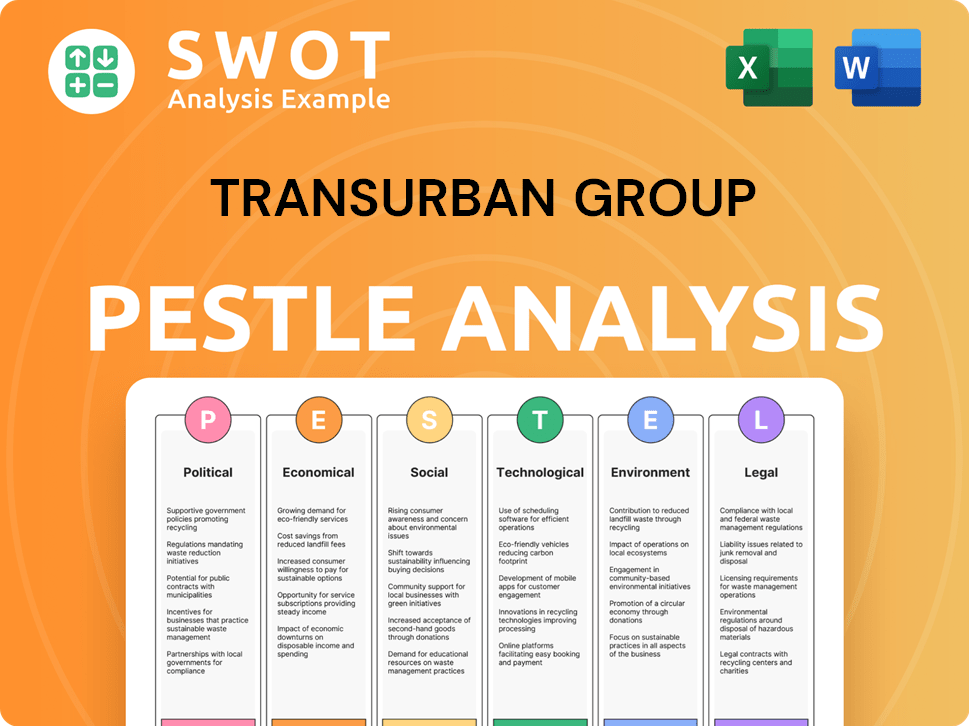
What are the key Milestones in Transurban Group history?
The Transurban Group has a rich history marked by significant milestones in the infrastructure sector. The company has evolved from its early projects to become a global leader in toll road development and operation, continually adapting to market changes and technological advancements.
| Year | Milestone |
|---|---|
| 1996 | Transurban was founded, marking the beginning of its journey in the Australian infrastructure market. |
| 1999 | The company listed on the Australian Securities Exchange (ASX), providing a platform for growth and investment. |
| Late 1990s | The CityLink project in Melbourne was completed, showcasing innovative electronic tolling systems. |
| 2000s | Transurban expanded its portfolio through acquisitions and new projects across Australia and North America. |
| 2010s-2020s | The company continued to invest in smart motorway technology and dynamic tolling, enhancing its operational efficiency. |
Transurban has been at the forefront of innovation in the toll road industry. A key innovation has been the early adoption and refinement of electronic tolling systems, which has significantly improved traffic flow and reduced congestion.
Transurban pioneered the use of electronic tolling, eliminating the need for toll booths and improving traffic flow. This technology has been crucial in managing congestion effectively across its network.
The company implemented dynamic tolling, adjusting prices based on traffic levels to optimize flow. This approach, also known as 'congestion pricing,' provides a reliable travel option for users.
Transurban has invested heavily in smart motorway technology, including intelligent transport systems (ITS) for real-time traffic monitoring. This allows for better incident management and improved road safety.
Transurban uses advanced data analytics to optimize traffic flow and improve operational efficiency. This data-driven approach helps in making informed decisions about road management and infrastructure improvements.
Transurban is increasingly focused on sustainability, including initiatives to reduce emissions and promote environmentally friendly practices. This includes the use of renewable energy and electric vehicle infrastructure.
The company actively engages with communities to address concerns and ensure transparency regarding toll road projects. This includes public consultations and feedback mechanisms to build trust and address public perception.
Throughout its history, Transurban has faced various challenges, including navigating complex regulatory environments and obtaining community acceptance for new toll road projects. Market downturns, such as the Global Financial Crisis, also impacted financing conditions, requiring robust financial management.
Transurban has had to navigate complex regulatory environments, which can impact project timelines and costs. This requires strong relationships with government bodies and a deep understanding of infrastructure regulations.
Gaining community acceptance for toll road projects and toll increases has been an ongoing challenge. Transurban addresses this through transparent communication and community engagement initiatives.
Significant market downturns, such as the Global Financial Crisis, impacted financing conditions for large infrastructure projects. This necessitated robust financial management and strategic partnerships.
Public perception regarding toll road pricing and accessibility has been an ongoing challenge. Transurban addresses this through transparent communication and community engagement initiatives.
The company continuously refines operational efficiencies to manage costs and improve service delivery. This includes optimizing tolling systems and traffic management technologies.
Enhancing stakeholder engagement has been critical in addressing challenges and building support for projects. This involves regular communication and collaboration with various stakeholders.
Transurban Group Business Model Canvas
- Complete 9-Block Business Model Canvas
- Effortlessly Communicate Your Business Strategy
- Investor-Ready BMC Format
- 100% Editable and Customizable
- Clear and Structured Layout
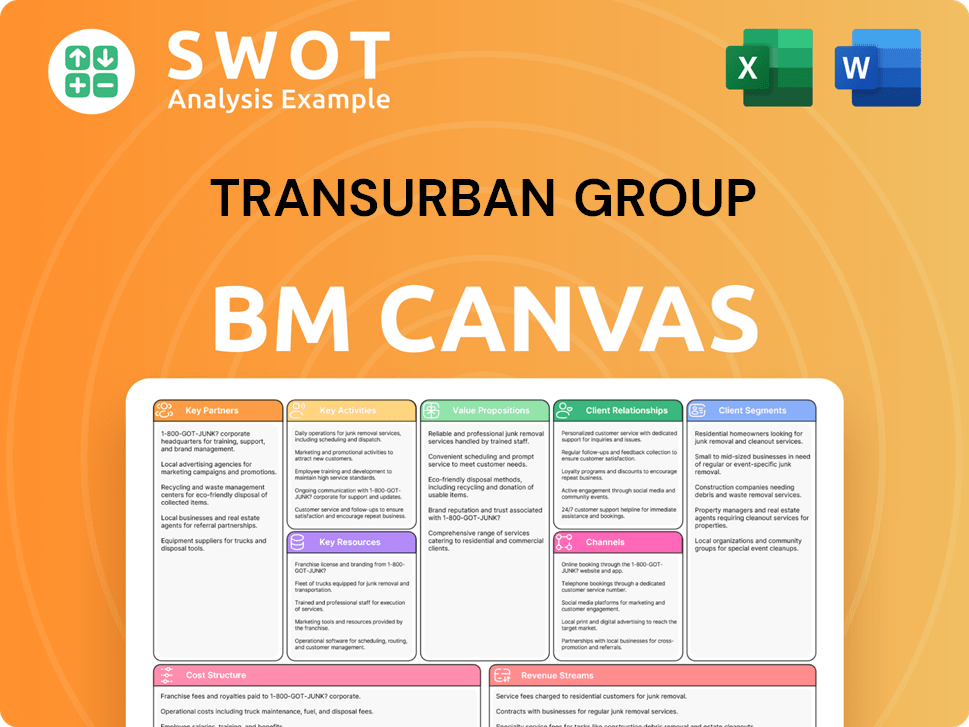
What is the Timeline of Key Events for Transurban Group?
The Transurban Group, a prominent player in infrastructure projects, has a rich history marked by strategic expansions and technological advancements. From its inception in Melbourne, Australia, the company has grown to become a significant operator of toll roads and other infrastructure assets across multiple continents. This journey showcases its ability to adapt to changing market dynamics and capitalize on opportunities within the transportation sector. The company's evolution reflects its commitment to innovation and sustainable infrastructure solutions.
| Year | Key Event |
|---|---|
| 1995 | Transurban Group was founded in Melbourne, Australia, setting the stage for its future in infrastructure development. |
| 1996 | Construction began on the CityLink project in Melbourne, representing the company's foundational asset. |
| 2000 | CityLink became fully operational, introducing electronic tolling as a key feature. |
| 2005 | The company made its initial entry into the North American market, expanding its global footprint. |
| 2008 | Operations commenced on the 495 Express Lanes in Virginia, US, utilizing dynamic tolling. |
| 2010s | Transurban continued its expansion in Australia and North America through new concessions and strategic acquisitions. |
| 2018 | The acquisition of the A25 toll road in Montreal, Canada, marked the company's entry into the Canadian market. |
| 2020 | The company emphasized digital transformation and enhancing customer experience via technology. |
| 2023 | Reported an average daily traffic growth of 1.4% in the first half of FY24 across its Australian and North American networks, demonstrating sustained demand for its infrastructure. |
| 2024 | The company is exploring opportunities for network optimization and further expansion, including potential new projects and technological enhancements. |
Transurban is focused on leveraging technology and data to improve urban mobility. This includes integrating advanced analytics, artificial intelligence, and connected vehicle technology to optimize traffic flow. The company aims to enhance safety and efficiency across its networks through these technological advancements. This strategy is crucial for managing increasing traffic volumes effectively.
The company plans to expand in existing markets and explore new geographies, particularly where urban congestion is a major issue. Transurban is focused on sustainable and technologically advanced transportation solutions. The asset recycling program, where mature assets are sold to fund new developments, will continue to be a key strategy for capital allocation, as it has proven effective.
Transurban is actively preparing for the impact of electric vehicles and autonomous driving. They are investing in infrastructure to support these emerging technologies and exploring new revenue streams beyond traditional tolling. This proactive approach ensures the company remains competitive and adaptable in a changing market. The company is focused on long-term sustainability.
Analyst predictions and leadership statements often highlight Transurban's strong pipeline of potential projects and its resilient business model. This is underpinned by long-term concessions and inflation-linked tolls. The company's future outlook remains closely tied to its original vision of addressing urban congestion with innovative and efficient infrastructure. The company's approach is designed to deliver consistent returns.
Transurban Group Porter's Five Forces Analysis
- Covers All 5 Competitive Forces in Detail
- Structured for Consultants, Students, and Founders
- 100% Editable in Microsoft Word & Excel
- Instant Digital Download – Use Immediately
- Compatible with Mac & PC – Fully Unlocked
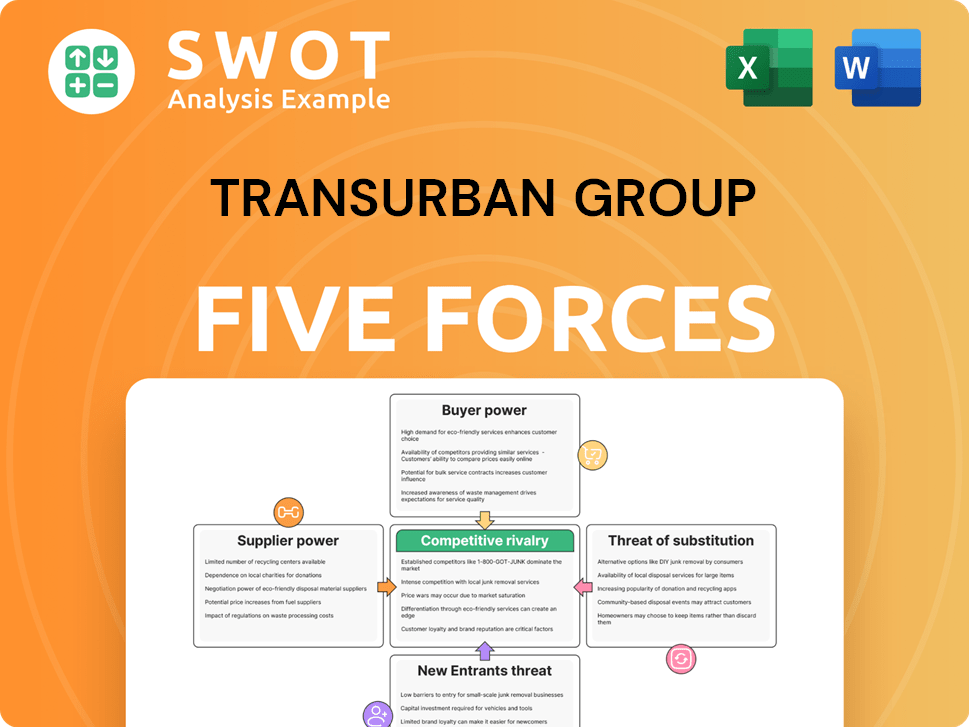
Related Blogs
- What is Competitive Landscape of Transurban Group Company?
- What is Growth Strategy and Future Prospects of Transurban Group Company?
- How Does Transurban Group Company Work?
- What is Sales and Marketing Strategy of Transurban Group Company?
- What is Brief History of Transurban Group Company?
- Who Owns Transurban Group Company?
- What is Customer Demographics and Target Market of Transurban Group Company?
Disclaimer
All information, articles, and product details provided on this website are for general informational and educational purposes only. We do not claim any ownership over, nor do we intend to infringe upon, any trademarks, copyrights, logos, brand names, or other intellectual property mentioned or depicted on this site. Such intellectual property remains the property of its respective owners, and any references here are made solely for identification or informational purposes, without implying any affiliation, endorsement, or partnership.
We make no representations or warranties, express or implied, regarding the accuracy, completeness, or suitability of any content or products presented. Nothing on this website should be construed as legal, tax, investment, financial, medical, or other professional advice. In addition, no part of this site—including articles or product references—constitutes a solicitation, recommendation, endorsement, advertisement, or offer to buy or sell any securities, franchises, or other financial instruments, particularly in jurisdictions where such activity would be unlawful.
All content is of a general nature and may not address the specific circumstances of any individual or entity. It is not a substitute for professional advice or services. Any actions you take based on the information provided here are strictly at your own risk. You accept full responsibility for any decisions or outcomes arising from your use of this website and agree to release us from any liability in connection with your use of, or reliance upon, the content or products found herein.